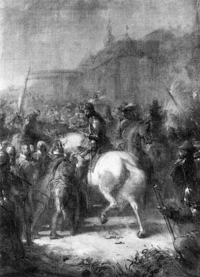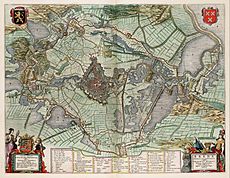Siege of Breda (1637) facts for kids
Quick facts for kids Siege of Breda (1637) |
|||||||
|---|---|---|---|---|---|---|---|
| Part of the Eighty Years' War | |||||||
 Surrender of Breda by Johannes Hinderikus Egenberger. |
|||||||
|
|||||||
| Belligerents | |||||||
| Commanders and leaders | |||||||
| Strength | |||||||
| 18,000 | 2,000 | ||||||
| Casualties and losses | |||||||
| 850 dead 1,300 wounded |
Unknown | ||||||
The Siege of Breda in 1637 was a big battle during the Eighty Years' War. This war was fought between the Dutch Republic and Spain. During this siege, the Dutch leader, Frederick Henry, Prince of Orange, took back the city of Breda.
Breda had been captured by the Spanish in 1625. After the 1637 siege, Breda stayed under Dutch control. It remained Dutch until the end of the war.
Why Breda Was Important
A City Caught in Conflict
In 1635, France and the Dutch Republic teamed up against Spain. Their goal was to take over parts of the Spanish Netherlands. They attacked from two sides. But soon, the Spanish army pushed them back to the Dutch border.
Spain then surprised everyone by capturing a very important fort called Schenkenschans. This forced the Dutch army to spend nine months trying to get it back. It was a long and expensive fight.
Spain's Focus Shifts
After the Dutch got Schenkenschans back in April 1636, Spain's commander, Cardinal-Infante Ferdinand of Austria, turned his attention to France. This meant the Spanish army moved away from the Dutch border. This made the Dutch Republic safer for a while.
In the summer of 1636, the Cardinal-Infante reached a city called Corbie. But the French took it back in November. By the end of that year, Spain had lost most of the land it had gained.
Frederick Henry's Personal Goal
For the 1637 fighting season, Spain planned to attack France again. But then, news arrived that the Dutch army had suddenly surrounded Breda. They had 18,000 soldiers ready for a siege.
Breda was a very special city to Frederick Henry. It was once the main city of his family's lands in the Netherlands. So, he really wanted to get it back.
The Siege Begins
First Attempts and Defenses
The siege started with a surprise attack attempt on July 21, 1637. Dutch cavalry tried to sneak into the city. But the gates were closed in time, and the Dutch were pushed back.
From July 23, the Dutch army first captured villages around Breda. Frederick Henry set up his main camp in Ginneken. Then, his soldiers started digging two long lines of trenches. These lines would eventually stretch for 34 kilometers (about 21 miles) around the city.
One outer trench line was 8 feet deep and 16 feet wide. This protected the Dutch attackers from any Spanish armies trying to help Breda. The Dutch also flooded the low-lying areas outside their defenses by blocking some rivers.
A Different Kind of Siege
Unlike a previous siege of Breda in 1624-1625, Frederick Henry did not plan to just wait for the city to run out of food. He wanted to attack more directly.
The Spanish commander, Cardinal-Infante Ferdinand, tried to help Breda. But he could not break through the Dutch defenses. So, he gave up trying to lift the siege. Instead, he moved his army and captured two Dutch cities, Roermond and Venlo. This was a big loss for the Dutch.
Attacking the Fortifications
While the Spanish were busy elsewhere, the Dutch kept digging. They dug covered trenches from their outer lines towards the city's defenses. These defenses were called hornworks. They were strong, star-shaped forts built by the Dutch themselves before the war.
Two trenches were dug towards the Ginneken Gate. One was dug by French soldiers, and the other by English soldiers. The French finished their trench on August 27, and the English finished theirs a day later. Soldiers used bundles of sticks called fascines to fill the moats.
On September 1, the French and English soldiers climbed over the walls of the hornwork. That same night, a French leader, Girard de Charnacé, was sadly killed by a bullet.
Taking the Hornwork
The attackers then started digging tunnels under the hornwork. This is called mining. On September 7, they set off an explosion in one of these tunnels. This blew a hole in the walls.
A captain named George Monck, who later became a famous general, was one of the first to enter the broken wall. The hornwork was captured! However, a few days later, another mine exploded by mistake. Another attack was pushed back, and many Dutch and Scottish soldiers were lost. Even so, the defenders left this part of their outer defenses to the Dutch.
The Final Push
On October 2, Count Henry of Nassau managed to capture a small fort called a lunette and another defense called a ravelin. He pushed the Spanish defenders back into the main city. This meant the city was now open to attack from underground tunnels.
The Spanish soldiers inside Breda knew they could not win. They had fought bravely. So, on October 6, their leader, Gomar de Fourdin, asked for an honorable surrender. The agreement was signed. On October 11, the Spanish soldiers marched out of Breda with their flags flying and drums playing. They headed towards Mechelen.
What Happened Next
End of the Campaign Season
Spain almost captured another important fort called Rheinberg about a month after Breda fell. But then the fighting season of 1637 ended.
In the next year, the Spanish army had to play defense. They were attacked by both France and the Dutch Republic. Frederick Henry tried to capture the city of Antwerp. But his lead group of soldiers was caught by a strong Spanish force on June 20, 1638. They were defeated in a battle at Kallo. This was the only big open battle in the second half of the Eighty Years' War.
Images for kids
See also
 In Spanish: Sitio de Breda (1637) para niños
In Spanish: Sitio de Breda (1637) para niños



